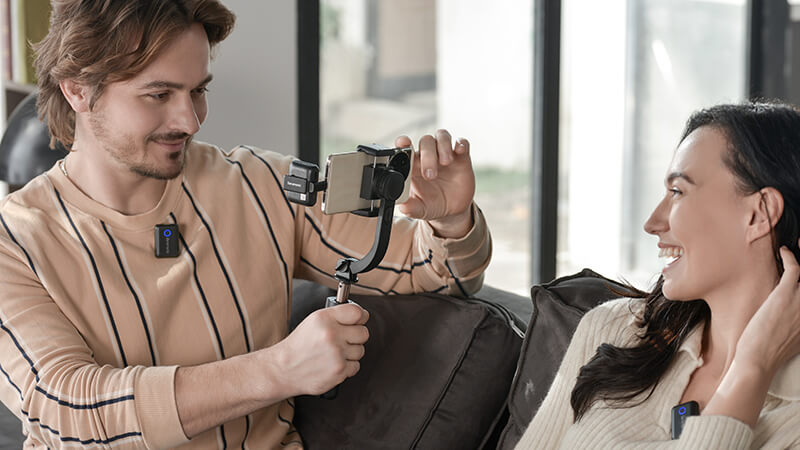Think about the last great presentation you saw—chances are, the speaker's voice was perfectly clear, right? Great audio isn't just nice to have; it's essential for getting your point across effectively. That's where a good wireless microphone shines. Choosing the right one lets your voice come through perfectly, gives you the freedom to move naturally, and helps you deliver a polished, professional talk without being tethered by cables.

So, what's the big deal with wireless mics? They simply let you ditch the cord! Instead of being stuck behind a lectern, you can walk around the stage or room freely. The microphone captures your voice and sends the signal wirelessly to the sound system, making it much easier to connect with your audience naturally.
Whichever style you prefer, a quality wireless microphone system helps ensure your voice remains clear and easy to hear, keeping your audience tuned in to what you're saying.
When you're picking out a wireless mic for your talks, here are the main things to focus on—they make a real difference:
Honestly, this is probably the most important thing. You just want your voice to sound clear and natural, like you're talking right to people, not like you're muffled or far away. Good mics capture your voice well and help keep out distracting background hiss. When the sound is crisp and clear, your audience can easily tune in to your message.
Think about the rooms you usually present in. Are they small, medium, or pretty big? You need a mic system that lets you move around naturally without the sound breaking up, getting static-y, or cutting out completely. Check the product details for the "range"—just" make sure it’s enough distance for the spaces you'll be in.
Picture this: you're right in the middle of making a great point, and your mic dies. Total buzzkill! So, definitely check how long the battery is supposed to last. Find out if it uses regular batteries (like AAs) you can swap out or if it has a rechargeable one. You need enough power to comfortably get through your entire presentation, questions and all, without worrying about it quitting on you.

If you're looking for a specific recommendation, the Saramonic Ultra is definitely one worth considering. It's getting a lot of buzz because it manages to pack professional-grade features into a system that's still pretty easy to handle.
Then why is it good for presentations? First of all, it's designed to yield extremely clear sound. It has intelligent noise-canceling technology (ClearVoice™) that eliminates background chatter if the room is particularly noisy. And it can handle loud sounds without distortion, so your voice ought never to sound awkward. Fearing venturing too far away from the receiver? The Ultra has a good distance range—up to approximately 300 meters (nearly 1000 feet)—and you've got plenty of space to move around, even in bigger spaces.
They've also ruggedized it and made it simple to use. The receiver comes with a handy little touchscreen, and automatic gain control is just one of a number of features that let your sound levels adjust dynamically. Add in decent battery life (around 6 hours) and even some water resistance on the part you wear, and it seems built to reliably withstand the demands of regular presentations. It's also prepared to plug into most cameras, computers, or sound systems right out of the box.
Alright, let's get down to brass tacks—the cost. Wireless mics come in all sorts of price ranges. Knowing what you generally get for your money can help you decide.
You can totally find good, usable wireless mics for around $100 to $250, such as the Saramonic Blink500 B2+. They might not reach across a giant hall or have every possible feature, but for smaller rooms or simpler talks, they often work just fine.
Spending a bit more, usually somewhere between $250 and $600, often gets you the best bang for your buck. The sound quality is usually noticeably better, they tend to be more reliable when you move further away, and they feel a bit more solid. Lots of really popular and dependable mics fall into this group. It's cool because sometimes you find systems loaded with great features, like the Saramonic Ultra (around $269), sitting right in this category—a really good deal!
If you present in big places often, absolutely need it to work perfectly every single time, or just want the very best sound quality possible, then you'll be looking at the higher-end stuff. These usually start around $600 and can go way up from there. You're paying for amazing sound clarity, features that expertly dodge interference, the longest possible range, and stuff built specifically for pros. It costs more, sure, but you're buying serious reliability and that professional edge.
| Price Range | Features | Best Use Cases |
| $100-$250 |
- Affordable, ideal for budget-conscious buyers - Basic handheld or clip-on lavalier microphones - Simple functionality, suitable for small rooms or basic setups |
Small meetings, casual presentations |
| $250-$600 |
- Noticeably better sound quality - Reliable over longer distances - Solid build with added features (e.g., Saramonic Ultra at $269) |
Medium-sized venues, dependable setups |
| $600 and above |
- Exceptional sound clarity - Advanced interference avoidance - Long range and professional-grade reliability |
Large venues, professional events |
Picking the best wireless mic doesn't have to be complicated, but it does take a little thought about your specific needs. Here’s what to keep in mind:
Where do you usually give presentations? A small meeting room needs something different than a huge auditorium. Knowing the size of the place helps you figure out how much range you need—basically, how far the mic needs to be from the receiver to send the signal clearly. It also gives you a heads-up about potential interference problems, like static from other wireless gadgets nearby.

Fancy features are cool, but the main thing is making sure people can hear you clearly and that the sound doesn't drop out. Look for mics that are known for having a strong, steady signal and just plain good sound quality. Seriously, a mic that crackles, cuts out, or makes you sound like you're talking through a tin can is worse than having no microphone at all!
This might sound super basic, but definitely double-check that the mic system will actually connect to the speaker, sound system, or computer you plan to use. Take a look at the plugs on the receiver (that's the little box that picks up the mic's signal). Does it have the right connection (like a standard headphone-style jack or maybe a USB) to fit into your equipment? Checking this simple thing first can save you a big headache later on.